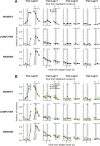Lateral intraparietal cortex and reinforcement learning during a mixed-strategy game
- PMID: 19494150
- PMCID: PMC2743508
- DOI: 10.1523/JNEUROSCI.1479-09.2009
Lateral intraparietal cortex and reinforcement learning during a mixed-strategy game
Abstract
Activity of the neurons in the lateral intraparietal cortex (LIP) displays a mixture of sensory, motor, and memory signals. Moreover, they often encode signals reflecting the accumulation of sensory evidence that certain eye movements might lead to a desirable outcome. However, when the environment changes dynamically, animals are also required to combine the information about its previously chosen actions and their outcomes appropriately to update continually the desirabilities of alternative actions. Here, we investigated whether LIP neurons encoded signals necessary to update an animal's decision-making strategies adaptively during a computer-simulated matching-pennies game. Using a reinforcement learning algorithm, we estimated the value functions that best predicted the animal's choices on a trial-by-trial basis. We found that, immediately before the animal revealed its choice, approximately 18% of LIP neurons changed their activity according to the difference in the value functions for the two targets. In addition, a somewhat higher fraction of LIP neurons displayed signals related to the sum of the value functions, which might correspond to the state value function or an average rate of reward used as a reference point. Similar to the neurons in the prefrontal cortex, many LIP neurons also encoded the signals related to the animal's previous choices. Thus, the posterior parietal cortex might be a part of the network that provides the substrate for forming appropriate associations between actions and outcomes.
Figures










Similar articles
-
Dynamic signals related to choices and outcomes in the dorsolateral prefrontal cortex.Cereb Cortex. 2007 Sep;17 Suppl 1:i110-7. doi: 10.1093/cercor/bhm064. Epub 2007 Jun 4. Cereb Cortex. 2007. PMID: 17548802
-
Temporal filtering of reward signals in the dorsal anterior cingulate cortex during a mixed-strategy game.J Neurosci. 2007 Aug 1;27(31):8366-77. doi: 10.1523/JNEUROSCI.2369-07.2007. J Neurosci. 2007. PMID: 17670983 Free PMC article.
-
Motor intention activity in the macaque's lateral intraparietal area. I. Dissociation of motor plan from sensory memory.J Neurophysiol. 1996 Sep;76(3):1439-56. doi: 10.1152/jn.1996.76.3.1439. J Neurophysiol. 1996. PMID: 8890265
-
Valuation of uncertain and delayed rewards in primate prefrontal cortex.Neural Netw. 2009 Apr;22(3):294-304. doi: 10.1016/j.neunet.2009.03.010. Epub 2009 Mar 29. Neural Netw. 2009. PMID: 19375276 Free PMC article. Review.
-
Mechanisms of reinforcement learning and decision making in the primate dorsolateral prefrontal cortex.Ann N Y Acad Sci. 2007 May;1104:108-22. doi: 10.1196/annals.1390.007. Epub 2007 Mar 8. Ann N Y Acad Sci. 2007. PMID: 17347332 Review.
Cited by
-
Value and choice as separable and stable representations in orbitofrontal cortex.Nat Commun. 2020 Jul 10;11(1):3466. doi: 10.1038/s41467-020-17058-y. Nat Commun. 2020. PMID: 32651373 Free PMC article.
-
Differentiating neural systems mediating the acquisition vs. expression of goal-directed and habitual behavioral control.Eur J Neurosci. 2015 May;41(10):1358-71. doi: 10.1111/ejn.12897. Epub 2015 Apr 18. Eur J Neurosci. 2015. PMID: 25892332 Free PMC article.
-
Neural basis of reinforcement learning and decision making.Annu Rev Neurosci. 2012;35:287-308. doi: 10.1146/annurev-neuro-062111-150512. Epub 2012 Mar 29. Annu Rev Neurosci. 2012. PMID: 22462543 Free PMC article. Review.
-
Distinct roles of rodent orbitofrontal and medial prefrontal cortex in decision making.Neuron. 2010 May 13;66(3):449-60. doi: 10.1016/j.neuron.2010.03.033. Neuron. 2010. PMID: 20471357 Free PMC article.
-
Temporal production signals in parietal cortex.PLoS Biol. 2012;10(10):e1001413. doi: 10.1371/journal.pbio.1001413. Epub 2012 Oct 30. PLoS Biol. 2012. PMID: 23118614 Free PMC article.
References
-
- Barash S, Bracewell RM, Fogassi L, Gnadt JW, Andersen RA. Saccade-related activity in the lateral intraparietal area. I. Temporal properties; comparison with area 7a. J Neurophysiol. 1991;66:1095–1108. - PubMed
-
- Barraclough DJ, Conroy ML, Lee D. Prefrontal cortex and decision making in a mixed-strategy game. Nat Neurosci. 2004;7:404–410. - PubMed
-
- Burnham KP, Anderson DR. A practical information-theoretic approach. Ed 2. New York: Springer; 2002. Model selection and multimodel inference.
Publication types
MeSH terms
Grants and funding
LinkOut - more resources
Full Text Sources
Molecular Biology Databases
